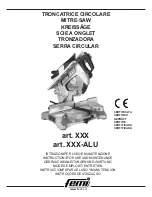
28
29
28
29
ADJUSTMENT
RIP FENCE ADJUSTMENT (FIG. Y)
1. The fence (1) can be repositioned
by lifting up the handle (2) and
sliding the fence to the desired
location. Pushing down the handle
locks the fence in position.
2. Position the fence (1) on the right
side of the table, and along one
edge of the miter gauge grooves.
3. Lock the fence handle (2). The
fence should be parallel with the
miter gauge groove.
4. If adjustment is needed to make the
fence parallel to the groove, do the
following:
●
Loosen the two screws (3) and
lift up on the handle (2).
●
Hold the fence bracket (4) firmly
against the front of the saw
table. Move the rip fence until
it is parallel with the miter
gauge groove.
●
Tighten both screws and push
the handle to lock.
5. If fence is loose when the handle is
in the locked (downward) position,
do the following:
●
Lift the handle (2) upward
and turn the adjusting nut (5)
clockwise using a 10 mm wrench
until the rear clamp is snug. Do
not turn the adjusting nut more
than 1/4 turn at a time.
●
Over-tightening the adjusting nut
will cause the fence to come out
of alignment.
Failure to properly align the fence
can cause “kickback” and serious
injury could occur.
RIP FENCE INDICATOR ADJUSTMENT
(FIG. Z)
1. The rip fence indicator (1) points
to the measurement scale (2). The
scale shows the distance from the
side of the fence to nearest side of
the blade.
2. Measure the actual distance with a
rule. If there is a difference between
the measurement and the indicator,
adjust the indicator (1).
3. Loosen the screw (3) and slide the
indicator to the correct measurement
on the scale (2). Tighten the screw
and remeasure with the rule.
Fig. Y
1
2
3
4
5
WARNING
!
















































